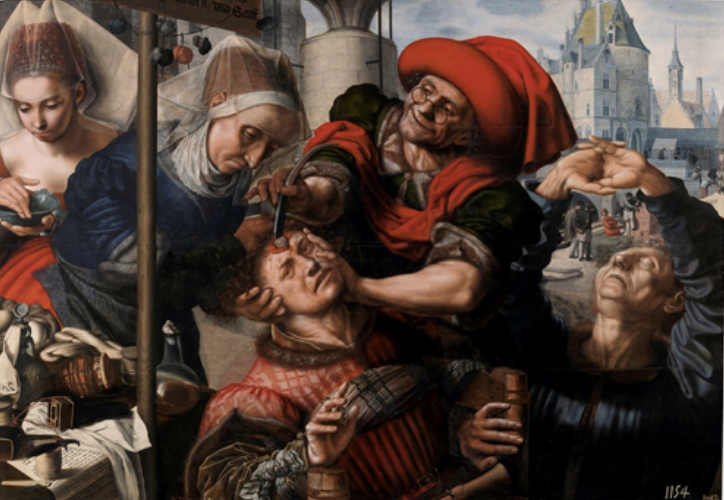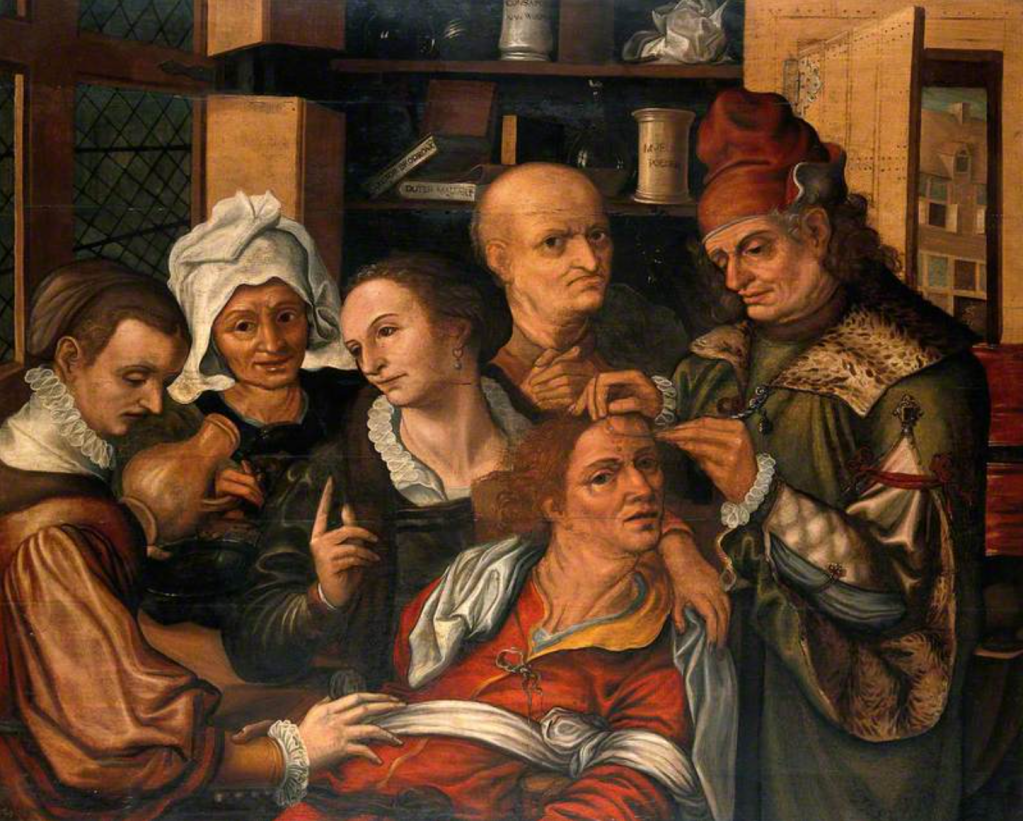Since the emergence of modern psychiatry in the 18th century, our perception of mental illnesses has tended to seek scientific definitions, explanations, and treatments of various psychiatric disorders. Mental disorders, as THE very special kind of maladies that we, reasonable human beings and science fanatics, defy a direct explanation for and definite physical pathology of, have a history worth discovering.
Through the obsolete, evolving, and “refining” perceptions of mental disorders throughout history, we could see how understandings of diseases like these are prone to social, moral, religious, and limited epistemology of the time.
So here comes the series: Madness!

The Extraction of The Stone of Madness, c.1494–1516, oil on panel by Hieronymus Bosch
“Doctor, quickly remove my stone.” Back in the Middle Ages, madness was believed to be caused by a stone in the cranium. The mentally ill would then reach out to a quack, and undergo a procedure called cranial lithotomy to remove the rock that brought the lunatic energy to them.
Absurd as it sounds, this practice is said not to be implemented much in reality. Even though trephination, the surgical procedure that drills and excises circular pieces of the skull, was actually practiced as early as the Neolithic times. During medieval times, cranial lithotomy was also usually practiced to treat diseases such as epilepsy instead of extracting the imaginary stone.
Therefore, instead of documenting a medical procedure, the motif of “extracting the stone of madness” is more of a symbolic and metaphorical value. Personally, I believe this motif has various ways of interpretation.

The Surgeon, or The Extraction of The Stone of Madness, c 1550, Jan Sanders van Hemessen, oil on panel
We want something concrete.
A brain disorder or a mental illness? Even when we leave behind how madness was defined back in the Middle Ages, reducing madness to a small rock that messed with our brain is a reductionist perspective that neglects the psychological and social aspects of mental illnesses. However, reducing the cause of mental illness to a physical, concrete subject – a rock – undoubtedly helps simplify the case and the treatment procedures.
Even in today’s world, the extent to which we equate psychiatric disorders to a biological basis is still debatable. Different from physical lesions, of which we could always find a concrete abnormality or dysfunction in our bodies, mental disorders have no single biological marker that is directly linked to the onset of the disease. Therefore, when we are excited about the neurosciences of psyciatry, we should not fall into eliminitavism or essentialism views of mental disorders that believe psychaitry will be reduced to neurology ultimately).
The satire: quacks, Doctor Mallard, and Lector Reckless!

Surgeon Extracting the Stone of Folly, c. 1561, Pieter Huys
In the Surgeon Extracting the Stone of Folly, we could find traces of the satiry in the motif of “stone of madness” in artworks. The medicine jars and books on the shelves in the background are labelled “Lector Reckless” and “Doctor Mallard,” which indicate that the surgeon who is looking for a rock is merely a quack. The reason why the patient is regarded as a fool might be that he has fallen into the trap of the quack. Moreover, in most paintings showing this motif, no stone is shown in the brain of the patient, which also hints on its metaphorical and ironic essense of the motif and the burlesque nature of such paintings.
The cruel treatment of abnormality.
Imagining being surrounded by a group of people who are trying to get your skull opened up. The helpless patient who is regarded as “mad” or “lunatic” is forced to undergo a cruel prucedure to remove the “abnormality” inside him or her. In Foucault’s Madness and Civilization, we see how madness is gradually excluded and confined by society. We could also see how “reasonable” people attempt to eliminate abnormality in society, even though the abnormal is forced to undergo painful and bizarre phrenopathic incision right on their forehead.
The limitation of medical doctrine…but have we found our answers yet?
Finally, we’d see how far we’ve went. From rock to neurotransmitters, psychaitry has definitely made attempts to find more reasonable and scientific etiology of mental illnesses. But today, we are still prone to misunderstanding and mis- or over-treatment of psychaitric disorders. In the case of mental health, we haven’t yet find our answers.
Reference:
Bordin, G., D’Ambrosio, P.L. and Hyams, J. (2010a) Medicine in art. Los Angeles: The J. Paul Getty Museum.
Banner N. F. (2013). Mental disorders are not brain disorders. Journal of evaluation in clinical practice, 19(3), 509–513. https://doi.org/10.1111/jep.12048
Chalif, E.J. (2023) ‘The surgeon, or the extraction of the Stone of Madness, by Jan Sanders van Hemessen (c 1500–1566)’, Neurosurgical Focus, 54(2). doi:10.3171/2022.11.focus22613.
Outstanding researchers present their work and share their opinions in Mapping Ignorance. (2023a) Extracting the stone of madness: The art of brain surgery in the Renaissance, Mapping Ignorance. Available at: https://mappingignorance.org/2023/03/01/extracting-the-stone-of-madness-the-art-of-brain-surgery-in-the-renaissance/ (Accessed: 19 January 2024).
The stone of folly: Madness or magic? (no date a) Art UK. Available at: https://artuk.org/discover/stories/the-stone-of-folly-madness-or-magic (Accessed: 19 January 2024).
留下评论